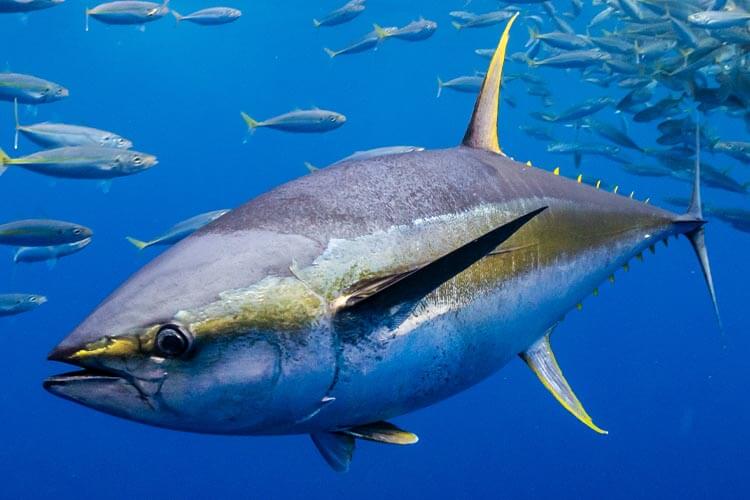
A new study suggests a potential narrowing habitat for tuna, with ripple effects on global fisheries and conservation
An international team of scientists from Marine Megafauna Foundation, the University of Southampton and Universidad San Francisco de Quito, has published a new study suggesting that the habitat of yellowfin tuna may narrow in the future as warming waters reduce the oxygen content of deeper parts of the ocean, limiting the tuna’s vertical range and making them more susceptible to overfishing.
Yellowfin tuna (Thunnus albacares) are fast-swimming fish with a high metabolic rate and, therefore, a high demand for oxygen. This mostly limits the depths in which tuna swim to the oxygen-rich waters near the ocean’s surface.
While most fish are cold-blooded and confined to a specific depth and temperature range, tuna are part of a small group of fish – which includes basking sharks and great white sharks – that, through the use of muscle tissue rich in blood vessels, are able to regulate their internal body temperature over and above that of the surrounding water.
Related articles:
As a result, tuna are able to dive into deeper, cooler water in search of prey, but – as oxygen content decreases with depth – the fish must go through a period of ‘re-oxygenation’ when they return to the surface, by reducing their heart rate, opening their mouths wider, and pumping water across their gills more rapidly.
Low oxygen zones of the ocean are usually found at depth, but ocean warming may cause these zones to expand towards the surface, potentially limiting the depth to which tuna – and other species – are able to dive, meaning they will spend more time in shallow water, where they are at greater risk of exploitation.
The new study was conducted around the Galápagos Islands, where oxygen-depleted zones are known to occur even in relatively shallow water. Yellowfin tuna are also known to have a high ‘site-fidelity’, in that they do not tend to migrate over large distances, affording the scientists a greater chance to track their movements around the region.

Researchers affixed satellite tags to eight yellowfin tuna and tracked their movements until the signal was lost, or the tag detached, and found that, for almost 90 per cent of the time, the fish remained in the oxygen-rich layer close to the surface, at an average depth of just over 24 metres; 50 per cent of their time was spent under 10m.
The tuna were also recorded – mostly during the day – intermittently diving into cooler, oxygen-depleted areas, a behaviour presumed to be an attempt to find prey when there is little available in the shallower water.
Understanding how fish stocks utilise the habitat in which they live is important for understanding how to best prevent their overexploitation in the future, especially with the potential for their habitats to be ‘compressed’, as the climate continues to change
Dissolved oceanic oxygen is predicted to decline by up to 7 per cent by 2100, according to the study, which has several implications: not only will the yellowfin tuna’s habitat be potentially compressed, but also that of its own predators and prey:
This means that the tuna have less space to hunt, they would come into contact more frequently with their own predators – and all of these species would be closer to the lines and nets of fishing vessels.
The study is part of the larger ‘Building Resilience in Galápagos Ecosystem Management to Severe Climate Change (R-GEMS)’ project, funded by the Royal Society, the primary objective of which is to devise a ‘fine-scale regional biogeochemical oceanographic model’ with the aim of predicting the potential impacts of climate change on species behaviour over the next five decades.
While this particular study is focused around the Galápagos Marine Reserve, its revelations hold global significance. The behaviour of the Galápagos tuna provides a snapshot into how marine species may need to adapt to their changing environments, offering a glimpse into potential future scenarios for the global oceanic ecosystem.
‘Our research on the yellowfin tuna in the Galápagos paints a cautionary tale of the future of global marine life in a changing climate,’ said MMF’s Dr Chris Rohner, lead author of the study. ‘The urgency to fortify our marine conservation efforts has never been clearer.’
The complete study, ‘Movement and vertical habitat use of yellowfin tuna Thunnus albacares in a vertically compressed habitat: the Galápagos Marine Reserve’, by Christoph A Rohner, Alberto C Naveira Garabato, and Alex R Hearn, is published online in the Journal of Fish Biology.


